Harpsichord by Christian Vater, 1738
Reconstruction following the original
Range: 4,5 octaves (A1,C-e3)
Pitch of the replicas: a1 = 415 Hz
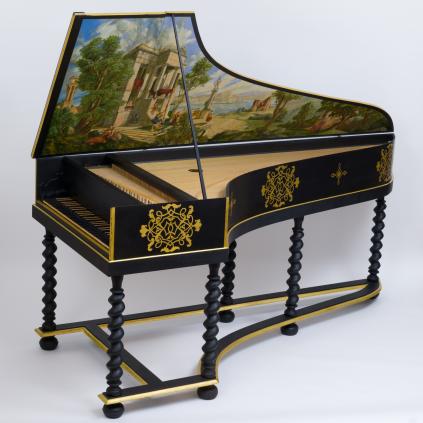
Christoph Graupner
(1683-1760):
Monatliche Clavier
Früchte: October, Darmstadt 1722
Varvara Manukyan (Interpretin)
Thomas Schwaiger (Musikproduktion)
Stimmtonhöhe: a1 = 415 Hz
Stimmung: Neidhardt - "Für die kleine Stadt"
Praeludium
Allemande
Autre (Air)
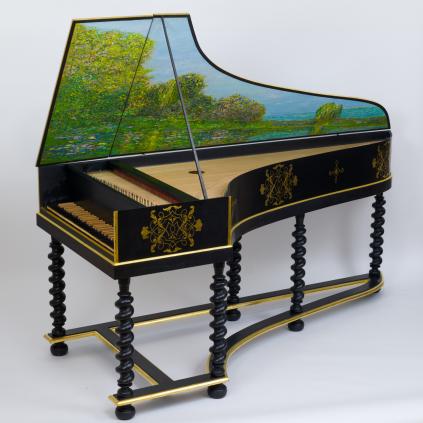
Christoph Graupner
(1683-1760):
Monatliche Clavier
Früchte: October, Darmstadt 1722
Varvara Manukyan (Interpretin)
Thomas Schwaiger (Musikproduktion)
Stimmtonhöhe: a1 = 415 Hz
Stimmung: Neidhardt - "Für die kleine Stadt"
Praeludium
Allemande
Autre (Air)
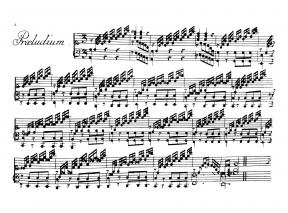
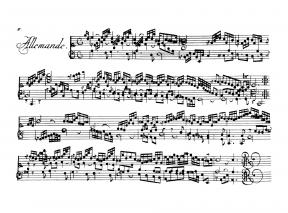
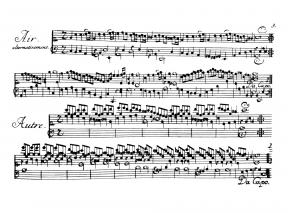
The original harpsichord by Christian Vater built in Hannover in 1738 is preserved in the Germanisches Nationalmuseum Nürnberg (examples of organs built by Vater see here and here). This second reconstruction was made in our workshop 2008 to 2011 by Magdalena Balk during her apprenticeship.
Vater's harpsichord has some rare peculiarities, for instance extremely thin jacks of only about 2.5 mm not unsimilar to organ trackers. These are guided in conical slits with a minimum of friction and probably had no lead weights thus enabling a very sensitive touch for the player, of a rather uncommon quality in harpsichords. This offers an interesting range but also challenge for the interpretation of German harpsichord music of the 18th century. The thin dimensions of the jacks mean also a considerable challenge in production, esp. when applying axles and in intonation.
The timbers used by Vater are birch for the descant wall, beech for the bent wall and spruce for the bass wall and internal parts. The beech wall board of 8 mm strength is prone to tearing while being bent, what can be prevented by a single clamp during the building process. The tension (thus prevention of further tearing) when assembled is counteracted by the birch descant wall, also passing the tension of the bend to the descant of the instrument thus aiding the resonance of the high register.
The base framework with turned columnar legs was made by Markus Thiel, gilding and coloration by Marlis Dörhöfer, the inner lid painting by Stephan Harmanus.


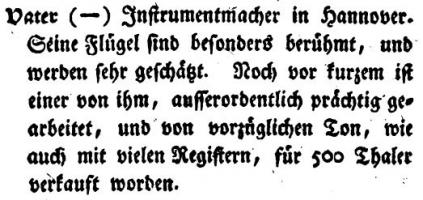
Aus dem Kapitel: "Verzeichnis der besten Instrumentenmacher in Deutschland"
Vater ( - ) Instrumentmacher in Hannover. Seine Flügel sind besonders berühmt, und werden sehr geschätzt. Noch vor kurzem ist einer von ihm, ausserordentlich prächtig gearbeitet, und von vorzüglichen Ton, wie auch mit vielen Registern, für 500 Thaler verkauft worden.
Vater (-) Instrument male in Hanover. His grands are particularly famous, and highly rated. Recently one, of particular splendour and excellent tone, and many ranks, has been sold for 500 Thalers.
Musical Almanac for Germany for the Year 1782," Nikolaus Forkel. From the chapter: "List of the Best Instrument Makers in Germany.



